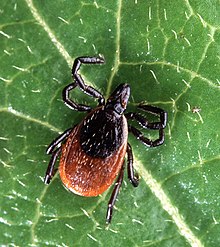Ixodes scapularis
| Ixodes scapularis | |
|---|---|
 |
|
| Adult female deer tick | |
| Scientific classification | |
| Kingdom: | Animalia |
| Phylum: | Arthropoda |
| Subphylum: | Chelicerata |
| Class: | Arachnida |
| Subclass: | Acari |
| Superorder: | Parasitiformes |
| Order: | Ixodida |
| Family: | Ixodidae |
| Genus: | Ixodes |
| Species: | I. scapularis |
| Binomial name | |
|
Ixodes scapularis Say, 1821 |
|
 |
|
| NCBI genome ID | 523 |
|---|---|
| Ploidy | diploid |
| Genome size | 1,765.38 Mb |
| Number of chromosomes | 15 pairs |
| Year of completion | 2008 |
Ixodes scapularis is commonly known as the deer tick or blacklegged tick (although some people reserve the latter term for Ixodes pacificus, which is found on the West Coast of the USA), and in some parts of the USA as the bear tick. It is a hard-bodied tick (family Ixodidae) of the eastern and northern Midwestern United States. It is a vector for several diseases of animals, including humans (Lyme disease, babesiosis, anaplasmosis, Powassan virus disease, etc.) and is known as the deer tick owing to its habit of parasitizing the white-tailed deer. It is also known to parasitize mice, lizards, migratory birds, etc. especially while the tick is in the larval or nymphal stage.
The image shown at the upper right—and in fact, most images of Ixodes scapularis that are commonly available—show an adult that is unengorged, that is, an adult that has not had a blood meal. This is natural, since ticks are generally removed immediately upon discovery to minimize the chance of disease. However, the abdomen that holds blood is so much larger when engorged and looks so different from the rest of the tick that it would be easy to assume that an engorged specimen of Ixodes scapularis is an entirely different tick (see photo below).
When the deer tick has consumed a blood meal, its abdomen will be a light grayish-blue color, whereas the tick itself is chiefly black. In identifying an engorged tick, it is helpful to concentrate on the legs and upper part of the body.
I. scapularis has a two-year life cycle, during which time it passes through three stages: larva, nymph, and adult. The tick must take a blood meal at each stage before maturing to the next. Deer tick females latch onto a host and drink its blood for four to five days. Deer are the preferred host of the deer tick, but it is also known to feed on small rodents. After she is engorged, the tick drops off and overwinters in the leaf litter of the forest floor. The following spring, the female lays several hundred to a few thousand eggs in clusters. Transtadial (between tick stages) passage of Borrelia burgdorferi is common. Vertical passage (from mother to egg) of Borrelia is uncommon.
...
Wikipedia
